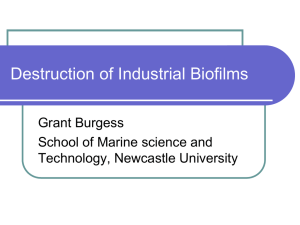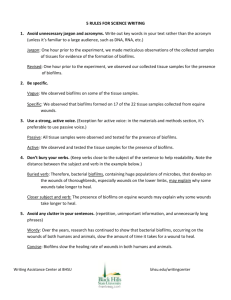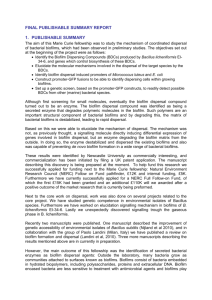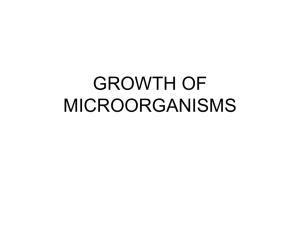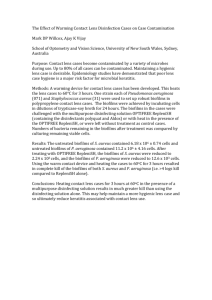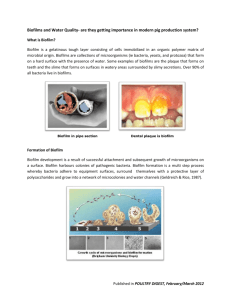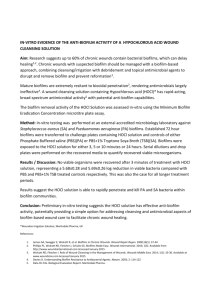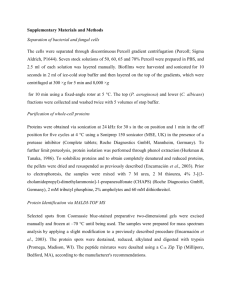Objectives of endodontic infections Control are achieved by
advertisement
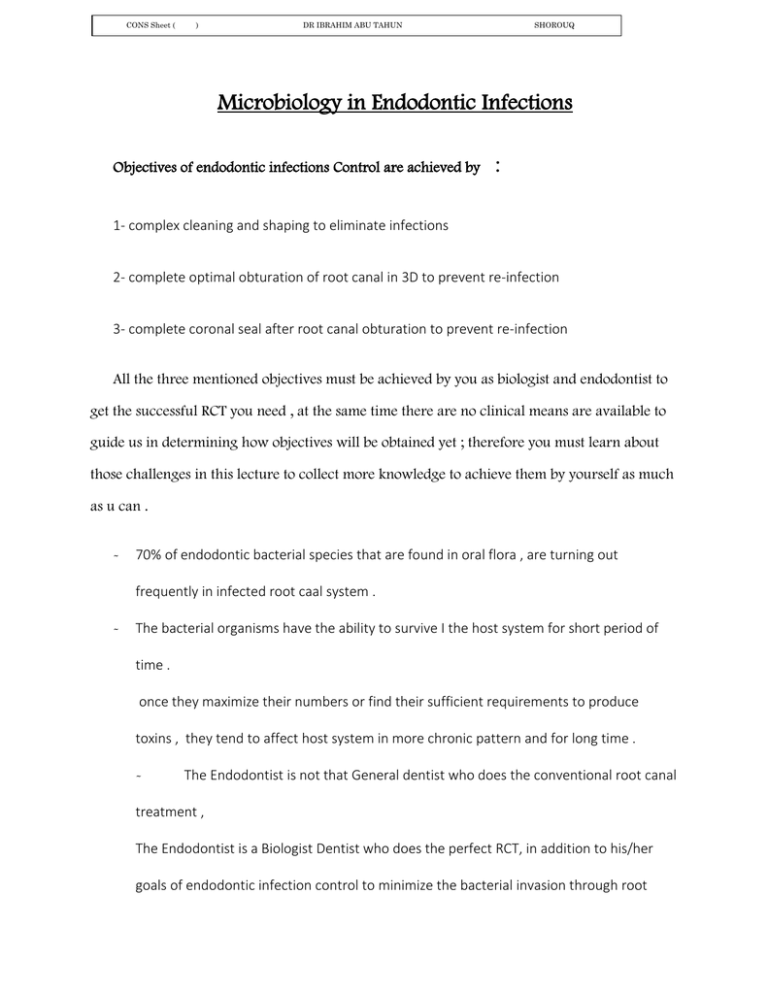
CONS Sheet ( ) DR IBRAHIM ABU TAHUN SHOROUQ KRISHAN Microbiology in Endodontic Infections Objectives of endodontic infections Control are achieved by : 1- complex cleaning and shaping to eliminate infections 2- complete optimal obturation of root canal in 3D to prevent re-infection 3- complete coronal seal after root canal obturation to prevent re-infection All the three mentioned objectives must be achieved by you as biologist and endodontist to get the successful RCT you need , at the same time there are no clinical means are available to guide us in determining how objectives will be obtained yet ; therefore you must learn about those challenges in this lecture to collect more knowledge to achieve them by yourself as much as u can . - 70% of endodontic bacterial species that are found in oral flora , are turning out frequently in infected root caal system . - The bacterial organisms have the ability to survive I the host system for short period of time . once they maximize their numbers or find their sufficient requirements to produce toxins , they tend to affect host system in more chronic pattern and for long time . - The Endodontist is not that General dentist who does the conventional root canal treatment , The Endodontist is a Biologist Dentist who does the perfect RCT, in addition to his/her goals of endodontic infection control to minimize the bacterial invasion through root canal , lateral , accessory canal and apex , and to minimize its distribution into periapical tissues and bone . - We watched a video about the role of polymorphocyte cells to attack bacteria cells immediately once it affects host cell , this video showed us How the PULP has this great self capacity to protect and recover itself effectively by its immune cells like neutrophils once bacteria affects the pulp zone , as long as our ability to control the process of infection as a dentist . - ----------------------------------------------------------- The bacterial pathways to the pulp are : 1- Caries , tooth surface loss , open cavity , cracks , attrition 2- indirect pulp exposure by cavity preparation 3- Dentinal tubules : Bacteria distribute itself throughout Dentinal tubules to reach into pulp , but Not all tubules are invaded by bacteria Localized bacterial distribution within canal because most of nutrients are within canal Once the cementum is eroded so the bacterial distribution will be diffused to form apical periodontitis 4- Root surface resorption : the cementum is exposed , so bacterial invasion will be occurred within dentine , finally the chronic apical periodontitis will be formed due to cemetnum loss . Where is the endodontic bacterial infections ? 1- They have the inflammatory nature 2- if the diversity of infection is increased , then the periapical lesion will be occurred 3- the condition of root canal infection guides the condition of apical lesion . so once the diversity and chronicity of root canal infection is occurred , this will lead to producing apical lesions . 4- the foci of bacterial infection is in “ Enemy Zone “ ; Enemy zone is the critical zone of infection and necrosis . Enemy zone is in Apical Area . Enemy Zone is your destination during RCT to get good results . 5- bacterial distribution pattern in each tooth was unique 6- the distribution on infection apically is more then coronally 7- the middle third of root canal has less bacterial distribution - Apical Periodontitis is “ the disease of endodontist “ , caused by bacterial infection in RCT . - A Scenario that you should read it to be a biologist dentist : Bacteria Release substances Mediators Induce immune response Mobile molecular phagocytes 1- Induce of destruction of canal tissue Prevent bacteria to gain access to bone & avoid osteomylitis and systemic effects 2- induce clinical signs and symptoms 3- lead to environmental changes that provide nature for bacteria - Clinical signs of active endodontic infection are pyrexia , trismus ,… , they all required Antibiotic Therapy . - (8-16) patients died because of Dentoalveolar abscesses , they are all medically compromised . - According to BILL BOOK , it is typed that “ 70-80 % cancer victims have root canal infections “ , this is totally WRONG . - Possibility of secondary infections is still existed today if treatment is delayed or if it’s not good just . - NO relation ever never between cancer and RC infection or RCT - even when shows a lesion , the life expectancy for the tooth is fairly good - Rule: if you want it to die , leave it or extract it - Rule: if you want it to live , do proper RCT . - The living Creatures are a testimony of their capacity to survive , they create a great evolutionary tree of life in RCT . - Quote : The bacteria occupy on foot of human intestine are more than people on the planet . - We don’t have that enough knowledge about bacterial behavior due to its genetic causes . - Miller 1894 : the first biologist who described the morphotypes of bacteria in apical area in compared to other parts of root canal . - Kakenashi 1965 : Japanese Biologist who showed the ultimate goal of pathogens . - Until 1975 : the role of anaerobic bacteria in pulpal disease was unknown , they believed that they are easily eliminated by irrigation and shaping . - After 1975 : the advancement of knowledge began , the culture techniques were developed . - Sundqvist Study : he showed the pathogenesis of Anaerobes - Dr Abu Tahun Study : used the similar cultures of sundqvist , he showed the Expanded Diversity of Microbes as found by sundqvist - The primary endodontic infections differ then other infections in our body , they are not caused by one specific microorganism , they are caused by polymicrobial complexity and mixture of facultative anaerobic G+ strains dominated by obligate anaerobes . - By Current cultures techniques , we can isolate up to 12 species (12 TAXA) using more sophisticated molecular techniques , while the actual estimated number of species in root canal is more than 90 species ( 90 Taxa ) - more than half of bacterial species are not cultivated yet - (1-12) TAXA are cultivated - 90 TAXA are undetected better - Fungi , candida albicans , Archea , viruses caused opportunistic infections that lead to RCT Failure. - Always , During RCT , “ don’t leave tooth open for sunshine “ . - RULE : if you file root canal , don’t close RULE : if you close , don’t file - According to our dental school , the tooth should be kept closed throughout RCT , IF you leave it open , your RCT is failed either you prescribe Antibiotics or you don’t , you are the reason of your Failure darling. - Patterns of endodontic microbes : 1- suspended ( planktonic state ) 2- adhered ( sessite state ) or known as ( Biofilm ) : this type that we will challenge them while RCT , they are so difficult to be eliminated totally , Biofilms caused the big puzzle in dentistry . - Irrigation studies (2006-2008) : planktonic are flooding in suspension and blocked by irrigation , the active dynamic irrigation is the perfect type to eliminate this flooding becteria and prevent dentine mud which is full of flooding bacterial and biofilms . - BIOFILMS : 1- 99 % of oral flora bacteria live as biofilms communities 2- adhered difficult type 3- in sessite state 4- act as single large multicellular organisms that has great intelligence and huge resistance due to its genetic cause . 5- the ratio between biofilms VS planktonic was unknown 6- the relation between certain species of biofilms and certain clinical signs was unknown, also . - BIOFILMS TYPES : 1- Intracanal ( dentinal ) biofilms 2- extra radicular biofilm : the type of biofilm that caused delayed healing , most critical type 3- periapical biofilm : common isolated 4- foreign body central biofilm : - *Caused by accumulation of actinomycosis *related to intracanal and extraradicular related to refractory periapical periodondtitis 77 % is the prevalence of biofilms in periapical periodontitis - The prevalence of biofilms in untreated teeth of PA Periodontistis will increased to 80 % - The prevalence of biofilms in treated teeth will decrease little to 74 % - So it clear that biofilms caused the most great challenge even after RCT - If there are large majority of teeth we are treating so you will deal with more biofilms - The cysts and wide lesion which are seen apically or radicularly , caused high challenge during RCT , because you are dealing with huge biofilms which they contained . There is a study concluded that if we have a big size of lesion , there is enough time to organize much biofilms , so high prevalence of biofilms organization . BUT there is No success rate about this previous study , you must know that : The cause of wide lesion bacterial Biofilms is not in its size (lower success rate ) but in the high complexity it contains . 95 % of biofilms are in cysts 83 % of biofilms are in abscess 69.5 % of biofilms are in granuloma - 6 % is prevalence of extraradicular biofilms , they are independent apical actinomycosis which persist the intraradicular eradication . - Main cause of failure is extraradicular biofilms - In endodontic we use formula called virulence soap which equal 1+1 >=2 - The synergism between biofilms follow virulence soap and the virulence soap is in the body of biofilms and it is theoretical term . - Virulence soap in endo means that the communities of biofilms act like Teamwork - Structural organisms of biofilms restrict the penetration of medicaments. - Biofilms have 1000 time more resistance to phagocytes and antibiotics. BIOLFILMS REMOVED BY : 1- Mechanical Removal by instruments and files but >40 % of root parts are not touched by instruments . 2- Dissolution of hypochlorite 3- Detachment by sonic and ultrasonic energy - Disrupt matrix by 3D cleaning and shaping and move mass into dissolution to eliminate it from endodontic space . - Multiple attached strategies of irrigation techniques are required instead of our traditional approach. - New of Novel: Multisonic techniques: ( son endo ): is one new techniques to eradicate biofilms by disruption and movement of biofilm mass in root canal space . Good Luck Shorooq krishan
